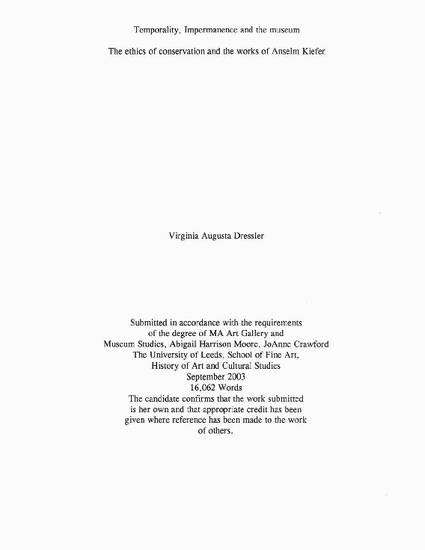
Thesis
Temporality, Impermanence and the museum The ethics of conservation and the works of Anselm Kiefer
(2003)
Abstract
Using some of the concepts from Heidegger's 'The origin of a work of art'
as a foundation, I will argue that every work is a unique and original entity, not
capable of being simulated or repeated by artificial means. A work is bound by the
temporal nature of its own material, as in all forms of matter. The product of
restoration work is ultimately a copy of the original, destroying a work's original
essence of time, material and space. Museums often present works as absolutes
within seemingly timeless walls of illusion. An environment of immortality is often
conveyed, where age and death do not seem to exist or have any effect. The idea of
an unchanging, immortal work is furthered by restoration work, where a work's
material surface is altered to extend life. Alternatively, preventative conservation
retains authenticity of a work's original material, space and point in time of creation
whilst the environment and structure is stabilised.
Keywords
- conservation,
- preservation,
- ethics,
- anselm kiefer,
- heidegger
Disciplines
Publication Date
June, 2003
Degree
Master of the Arts
Field of study
Art Gallery and Museum Studies
Department
History of Art and Cultural Studies
Advisor
Abigail Harrison Moore
Citation Information
Virginia A Dressler. "Temporality, Impermanence and the museum The ethics of conservation and the works of Anselm Kiefer" (2003) Available at: http://works.bepress.com/virginia_dressler/16/
Creative Commons license

This work is licensed under a Creative Commons CC_BY-NC-SA International License.
